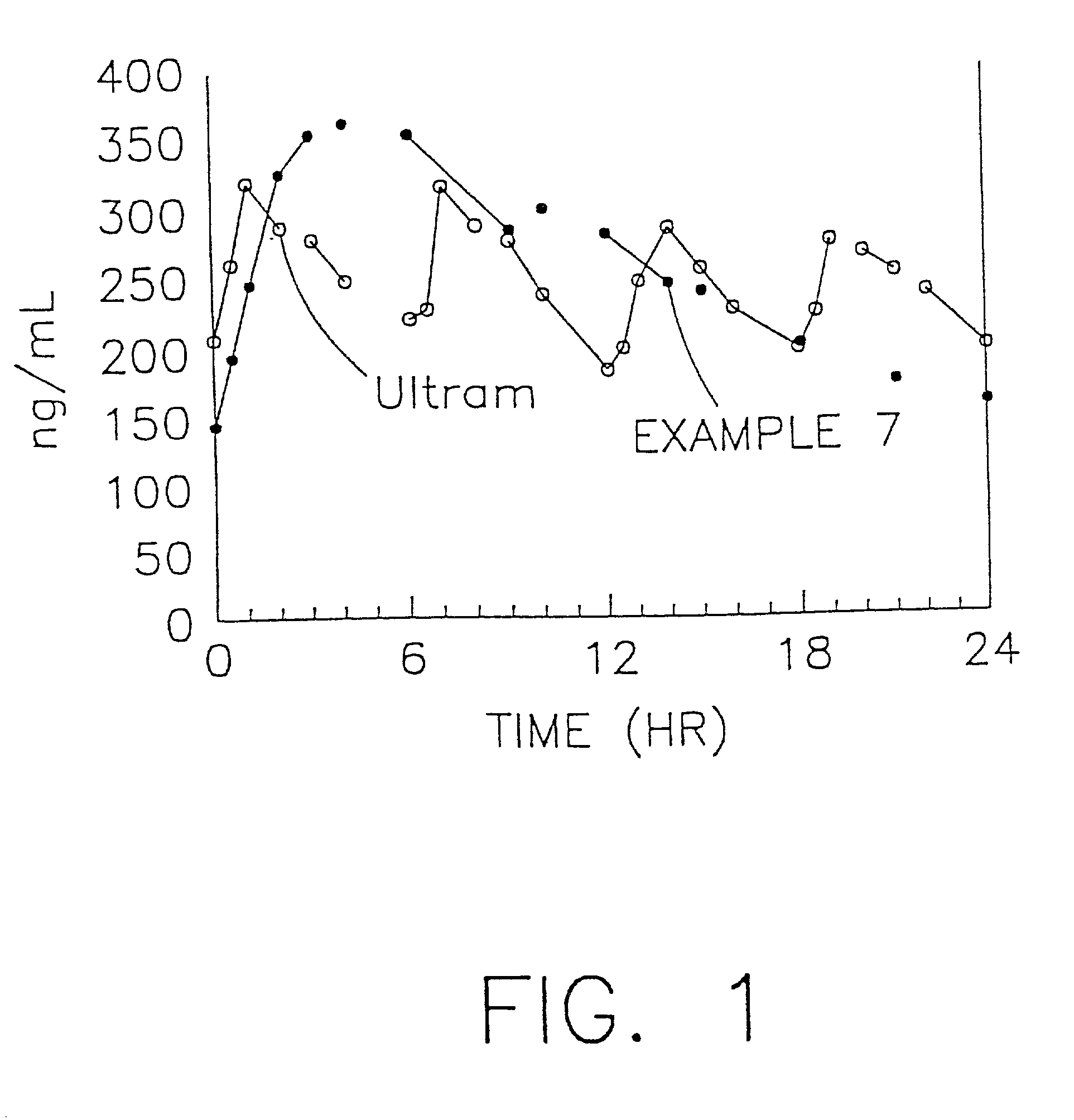Stabilized sustained release tramadol formulations
a formulation and tramadol technology, applied in the direction of biocide, oil/fat/waxes non-active ingredients, drug compositions, etc., can solve the problems of unpredictable variation in availability rate, waxes used in such formulations are known to undergo physical alterations on prolonged standing, and often present special problems in physical stability of sustained release dosage formulations , to achieve the effect of stable dissolution profile and lack of stability in such products
- Summary
- Abstract
- Description
- Claims
- Application Information
AI Technical Summary
Benefits of technology
Problems solved by technology
Method used
Image
Examples
example 2
[0112] The tablets of Example 2 were prepared using the same manufacturing process as Example 1. These two batch lots of tablets (Examples 1 and 2) showed similar drug release rates at time zero (dissolution was done right after manufacture, in accordance with the procedures set forth for Example 1). After one month storage under ambient conditions, the tablets showed a slower dissolution rate (dissolution conducted in similar fashion as Example 1). The uncoated tablets were then placed in a 50.degree. C. oven for 1 hour. The following results show that the dissolution rate of the tablet was significantly slower after curing at 50.degree. C. for 1 hour.
4TABLE 4 Example 2 Example 2 Example 2 Time (initial) (1 mo old) (1 mo old, 1 hr cure) (Hours) % Dissolved % Dissolved % Dissolved 1 18 16 12 2 25 23 16 4 34 32 23 8 48 45 33 12 58 56 41 18 72 69 52 24 83 79 60
[0113] The results showed that the drug release rate was significantly reduced by exposing to a high temperature, probably due...
example 3
[0114] In Example 3, tablets were prepared in the same fashion set forth in Example 1. The ingredients of the tablets prepared in Example 3 are set forth in Table 5 below:
5 TABLE 5 Ingredients % mg / tablet tramadol HCl 55.7 200 Ethocel Std 7 20.6 74 stearyl alcohol 20.6 74 talc 2.1 7.4 magnesium stearate 1.10 3.8 total: 100 359.2
[0115] Once the tablets of Example 3 were prepared, dissolution testing was conducted according to the procedure set forth in Example 1. The dissolution results are set forth in Table 6 below:
6 TABLE 6 Time Example 1 (Hours) % Dissolved 1 24 2 34 4 46 8 62 12 75 18 87 24 95
[0116] The results indicate that the dissolution rate of the tablets of Example 3 was faster than the targeted dissolution rate provided by Example 1. This was expected, and is due to the reduced amount of excipient used. The tablets of Example 3 were placed in 50.degree. C. oven for 1.5 hrs, 4 hrs, 3 days, 6 days, and 10 days. The dissolution results are listed as follows in Table 7.
7 TABL...
example 4
[0119] The lubricated granulation used to prepare Example 3 was used to make Example 4 in larger quantity. The tablets were further film-coated pursuant to the procedure set forth in Example 1 and cured at 50.degree. C. for 1, 2, 3, 6, and 9 days. The dissolution results are shown as set forth in Table 8 below:
8 TABLE 8 Time Cured at 50.degree. C. (hrs) 1 day 2 days 3 days 6 days 9 days 1 17 18 17 17 17 2 23 25 24 24 23 4 32 34 34 33 32 8 45 47 47 46 44 12 55 56 57 55 54 18 66 68 69 67 65 24 76 77 78 78 78
[0120] The results set forth in Table 8 above demonstrate that curing for a time period of 1 day at 50.degree. C. is sufficient to cure the tablets to a stable endpoint (at which the release rate of the drug from the formulation is unchanged after further exposure to accelerated storage conditions). A curing period of up to 9 days does not significantly change the dissolution profile of tramadol from the cured tablets.
[0121] The tablets which were cured at 50.degree. C. for 3 days ...
PUM
| Property | Measurement | Unit |
|---|---|---|
| temperature | aaaaa | aaaaa |
| temperature | aaaaa | aaaaa |
| temperature | aaaaa | aaaaa |
Abstract
Description
Claims
Application Information
 Login to View More
Login to View More - R&D
- Intellectual Property
- Life Sciences
- Materials
- Tech Scout
- Unparalleled Data Quality
- Higher Quality Content
- 60% Fewer Hallucinations
Browse by: Latest US Patents, China's latest patents, Technical Efficacy Thesaurus, Application Domain, Technology Topic, Popular Technical Reports.
© 2025 PatSnap. All rights reserved.Legal|Privacy policy|Modern Slavery Act Transparency Statement|Sitemap|About US| Contact US: help@patsnap.com

